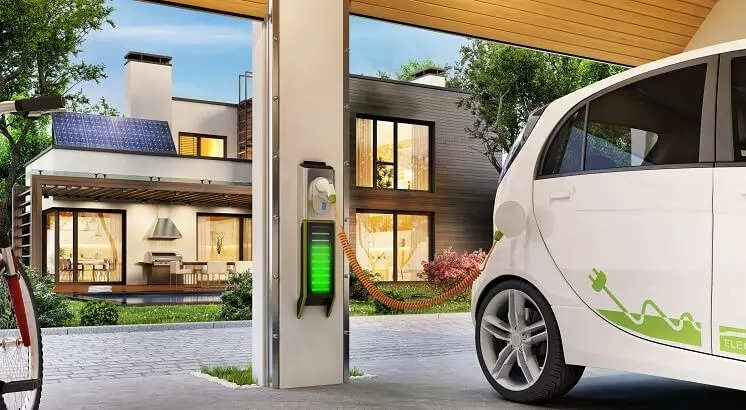
New Delhi: The adoption of solar rooftop technology is not just giving a fresh look to the rooftops of the Indian households and generating electricity for them, but also reshaping carmaker Tata Motors’ electric vehicle (EV) business strategy.
The market leader in the electric passenger vehicle segment suggests there is a clear value the rooftop solar users are finding in EV adoption.
“Solar rooftop installations are creating a pull for EVs. Certain states like Gujarat and Rajasthan have been active in solar energy adoption since the days of solar cookers. Our focus on sales is to prioritize those states which already have good solar rooftop penetration,” Balaje Rajan, Chief Strategy Officer, Tata Passenger Electric Mobility (TPEM) and Tata Motors Passenger Vehicles (TMPV), said.
The maker of Nexon EVs is working to create a “bundled offering for EVs and rooftop solar to provide tangible financial benefits to consumers”.
Based on an internal study, Tata Motors claims to see a direct relation between the states with highest EV adoption and highest penetration of solar rooftops.
State-wise installed capacity of Solar Power as on June 30, 2024
| S.No |
State |
Installed Capacity |
| 1 | Gujarat | 3818.78 MW |
| 2 | Maharashtra | 2270.04 MW |
| 3 | Rajasthan | 1226.74 MW |
| 4 | Kerala | 817.25 MW |
| 5 | Tamil Nadu | 679.20 MW |
Source: Ministry of New and Renewable Energy (MNRE)
What is further boosting Tata Motors’ confidence is the central government’s PM Surya Ghar Muft Bijli Yojana scheme that was unveiled early this year. The scheme aims to provide free electricity to one crore households in India who opt to install rooftop solar electricity units. With this, homeowners will be able to receive 300 units of free power each month.
Under the initiative, 40% cost is subsidized for systems between 2 and 3 kW capacity, while 60% of the cost of the solar unit is covered for systems up to 2 kW in capacity. There is a 3 kW capacity cap on the subsidy. According to the current benchmark rates, a 1 kW system will receive a subsidy of INR 30,000, a 2 kW system of INR 60,000, and a 3 kW system or more of INR 78,000.
“Solar rooftop systems are not that capital intensive. Even without subsidies, a 3kW system costs only less than INR 2 lakh, and this system lasts for about 10 years. So with an EV, one can save about 10%-15% of the cost of petrol,” Rajan said.
According to him, the installations are typically of 3kW systems and 1 kW of solar rooftop can generate an average of 120 units per month.
| FY24 | FY30 (Projected) | |
| % of grid with RE | 24% | 40% |
| % of Tata EV users with rooftop solar | 10-15% | 50% |
| % of RE used for Tata EV charging | ~33% | ~70% |
Source: Tata Motors Investor Report
Neeraj Kuldeep, Senior Programme Lead at policy research institute Council on Energy, Environment and Water (CEEW), suggests that while it is a bit difficult to establish the relationship between sales of passenger vehicles and EV adoption, it is anticipated that going forward both these technologies will complement each other.
“With increasing energy requirements, rooftop solar will definitely become attractive for people. There will be interlinkage between the two but currently both the sectors are at an early stage,” he said.
Data from the Ministry of New and Renewable Energy (MNRE) suggests that the cumulative Rooftop Solar (RTS) installed capacity increased from 1.8 GW as on March 31, 2019 to 10.4 GW as on November 30, 2023. The Compound annual growth rate (CAGR) of RTS installations is around 46%.
Over the next five years, the government has a target to achieve an annual solar power generation of 40 GW, looking at a 500 GW non-fossil fuel capacity by 2030. However, there is a significant gap to bridge with currently only 2.2 GW installed in homes.
Lack of awareness
Rajan said that there are so many households with solar rooftops where EVs could be an obvious choice, but most of them lack awareness. “Even with state subsidies, a few states have poor solar rooftop installation rate. A lot of awareness is still needed.”
At the national level, consumer awareness about rooftop solar energy was less than 50%, with awareness in most states at 30-50%, a November 2023 survey by CEEW found. At times, consumers may be aware of solar energy generation, however there is still a lack of awareness about the process– how to get government subsidies and net metering.
The policy research institute stated that the creation of a one stop platform for consumers at the state level to receive credible information about RTS. The intent is to provide consumers easy access to basic, reliable, and compelling information. These portals will cover information on RTS systems, government schemes, virtual/physical system tours, tools for pre-feasibility assessment, etc. They can regularly also host interactive webinars, virtual demonstration tours, doubt-clearing sessions, and competitions.
Challenges exist for rural and urban
With regards to the increasing urbanization in metro cities, technical potential based on rooftop area is much higher in rural (about 363 GW) owing to higher average roof space compared to urban areas (about 274 GW), CEEW suggests. However, the upfront costs of the installation can be a deterrent in rural areas, which makes financing and lifecycle management play a pivotal role for widespread adoption.
For instance, Kerala has higher EV penetration than other states. The rooftop solar accounts for 69% of the total solar power output in Kerala (622/902 MW) and is a crucial contributor to the growing EV adoption. However the access is still majorly limited to urban households, with rural people facing challenges of awareness and cost.
Experts suggest leasing and power purchase agreements (PPAs) can offer flexible payment structures. Dedicated NBFCs could also help to bridge the gap of quick financing for solar projects, although interest rates may still be higher compared to traditional banks. However, the solar rooftop installation market is fairly fragmented as there are multiple local vendors.
A Tier-1 module manufacturer that ETAuto talked to, is hopeful that the PM Surya Ghar scheme can solve this challenge as it mandates registered vendors to provide comprehensive maintenance contracts (CMCs) for five years. “This will ensure optimal system performance and robust after-sales support significantly reduces long-term ownership concerns.”






